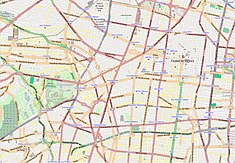El Ángel
| The Angel of Independence | |
|---|---|
|
Native name Spanish: Monumento a la Independencia, Ángel de la Independencia |
|

Independence Column front view
|
|
| Location | Mexico City, Mexico |
| Coordinates | 19°25′37.1994″N 99°10′03.7554″W / 19.426999833°N 99.167709833°WCoordinates: 19°25′37.1994″N 99°10′03.7554″W / 19.426999833°N 99.167709833°W |
| Elevation | 45 metres (148 ft) |
| Inaugurated by | Porfirio Díaz |
| Built | September 16, 1910 |
| Built for | Centenary of Mexican Independence |
| Restored | September 16, 1958 |
| Restored by | José Fernández Urbina |
| Architect |
Antonio Rivas Mercado Gonzalo Garita Manuel Gorozpe Enrique Alciati (sculptures) |
| Architectural style(s) |
Corinthian column Victory column |
| Governing body | Instituto Nacional de Antropología e Historia |
The Angel of Independence, most commonly known by the shortened name El Ángel and officially known as Monumento a la Independencia ("Monument to Independence"), is a victory column on a roundabout on the major thoroughfare of Paseo de la Reforma in downtown Mexico City.
El Ángel was built in 1910 during the presidency of Porfirio Díaz by architect Antonio Rivas Mercado, to commemorate the centennial of the beginning of Mexico's War of Independence. In later years it was made into a mausoleum for the most important heroes of that war. It is one of the most recognizable landmarks in Mexico City, and it has become a focal point for both celebration or protest. It resembles the July Column in Paris and the Berlin Victory Column in Berlin.
The base of the column is quadrangular with each vertex featuring a bronze sculpture symbolizing law, war, justice and peace. Originally there were nine steps leading to the base, but due to the sinking of the ground, an ongoing problem in Mexico City, fourteen more steps were added.
On the main face of the base facing downtown Mexico City, there is an inscription reading La Nación a los Héroes de la Independencia ("The Nation to the Heroes of Independence"). In front of this inscription is a bronze statue of a giant lion led by a child, representing strength and the innocence of youth during War but docility during Peace.
Next to the column there is a group of marble statues of some of the heroes of the War of Independence. The column itself is 36 metres (118 ft) high. The structure is made of steel covered with quarried stone decorated with garlands, palms and rings with the names of Independence figures. Inside the column is a two-hundred step staircase which leads to a viewpoint above the capital. The Corinthian-style capital is adorned by four eagles with extended wings from the Mexican coat of arms used at the time.
...
Wikipedia

